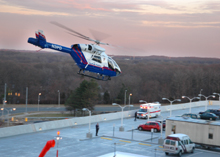

 |  |
TRAUMA SERVICE RANKED IN NATION'S TOP 4% BY FEDERAL HEALTHCARE RESEARCH AGENCY: New Report Recognizes Our Success

![]() In October 2008, the Agency for Healthcare Research and Quality — the nation's lead federal agency for research on healthcare quality, costs, outcomes, and patient safety — issued a new report entitled "Survival Measurement and Reporting Trial for Trauma (SMARTT)" that puts our trauma service in the top 4% of trauma centers nationwide, with the lowest mortality for victims of injury.
In October 2008, the Agency for Healthcare Research and Quality — the nation's lead federal agency for research on healthcare quality, costs, outcomes, and patient safety — issued a new report entitled "Survival Measurement and Reporting Trial for Trauma (SMARTT)" that puts our trauma service in the top 4% of trauma centers nationwide, with the lowest mortality for victims of injury.
The SMARTT study uses the American College of Surgeons (ACS) national population-based trauma registry to set goals to improve patient outcomes.
Stony Brook's trauma service was cited with the highest recognition of being a "very high-quality hospital" in the SMARTT report, with the lowest mortality of any hospital in the United States in treating pedestrian trauma.
Stony Brook was also cited as second in the nation for saving the victims of "very high-risk trauma."
As the only Level 1 trauma center in Suffolk County, Stony Brook University Medical Center receives the most critically injured patients from all points of Suffolk County, and from every community and Level 2 trauma hospital in our region.
Some of the more prominent cases that were treated by the Stony Brook University Medical Center Trauma team include Victoria Ruvolo, whose face was badly injured when a group of teens threw a frozen turkey out their car window while passing her on the roadway; Arsenio Matias, whose hands were amputated and reattached following a tragic factory accident; and, construction worker Mike Norton, who was shot through the heart with a staple gun while on the job.
"Our Level 1 trauma center has a dedicated team of staff that treats multiply injured patients throughout their entire recovery," says Marc J. Shapiro, MD, professor of surgery and anesthesiology, and chief of general surgery, trauma, surgical critical care, and burns. "This team of trained professionals and para-professionals strives to return every patient to full function."
"We also place a high priority on performance improvement and research, so this report quantifies the significance of our efforts. We enact drills, we meet weekly, and we start the discharge planning process the day our patients arrive in the hospital. This is a positive approach to recovery, and we engage family members in the process, treating them as we would treat our own."
Funded by the Agency for Healthcare and Research Quality, which is the health services research arm of the U.S. Department of Health and Human Services, the goal of SMARTT is to inform governmental and other agencies of policies and practice that improve the quality of trauma care.
ABOUT THE SMARTT REPORT & METHODOLOGY
The SMARTT outcomes report is based on the National Trauma Data Bank. The NTDB contains outcomes data on nearly three million patients from nearly 80% of Level 1 and 70% of Level 2 trauma centers in the United States.
Stony Brook University Medical Center consistently provides data to the NTDB, and is one of approximately 125 centers selected to receive an annual report on risk-adjusted mortality and performance and, therefore, was compared to that of other centers included in the study.
The research consortium had access to encrypted hospital identifiers and study investigators, and the ACS was blinded to the identity of each hospital in the report.
The ACS was responsible for sending out the report cards, but did not view the content of individual hospital report cards.
All patients with trauma diagnoses are included with the exception of 1) patients younger than 1 year of age; 2) patients dead on arrival; 3) patients without age, gender, or outcome information; 4) or patients transferred out to another hospital. Patients admitted with burns, late effects of injuries, or traumatic complications were excluded from the report.

| Back to Departmental News | Return to Home Page |